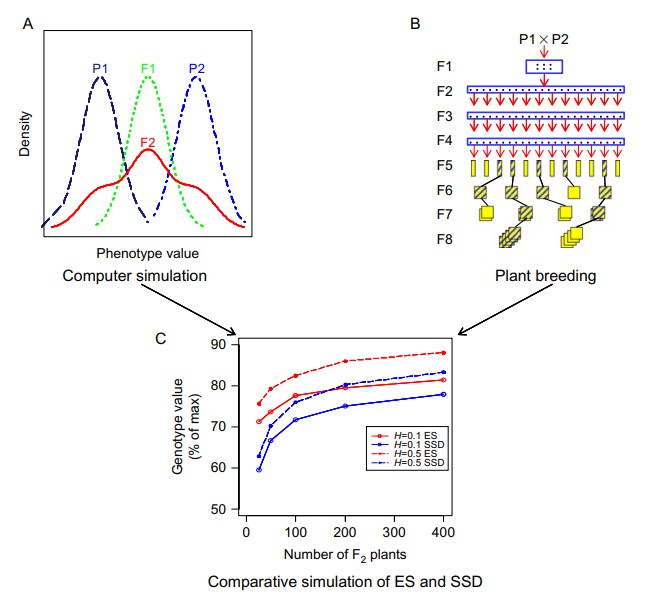Forage plant breeding programs are used to develop superior genotypes using available genetic and non-genetic resources, thereby maximizing genetic gain and cost-effectiveness. Quantitative genetics theory provides a framework for modeling the effects of genes within populations. Predictive equations for expected responses to selection have been constructed for a range of genetic models and breeding strategies. Computer simulation has become a powerful tool for scientific research as a bridge between theory and experiment. Computer simulations allow the breeding process to be laid out on a computer and the best candidates for various scenarios to be identified; empirical validation can then be performed. At the same time, insights gained from empirical studies can be incorporated into computer simulations. Because computer simulations are fast and use fewer physical resources, researchers can easily see why simulations and plant breeding are compatible.
 Fig.1. Joining computer simulation with plant breeding. (Li X et al., 2012)
Fig.1. Joining computer simulation with plant breeding. (Li X et al., 2012)
Forage plant breeding is a time-consuming and labor-intensive process, and decision-making and resource allocation are critical to the final outcome of breeding. Based on classical quantitative modeling and prediction methods, we focus on computer simulation models that can be developed for forage breeding programs. Our computer simulations can be adapted to genetic models with multiple genes, multiple alleles, pleiotropic and epistatic effects, and genotype-environment interactions.
As an ideal partner for forage molecular breeding, Lifeasible applies computer simulations to different research areas of forage breeding.
In most cases, it is impractical to conduct extensive experimental evaluations of forage breeding strategies that manipulate complex yield adaptation traits. A notable application of our computer simulations in forage breeding is combining knowledge of quantitative, molecular,, and plant breeding to predict the efficiency of different selection methods. We take into account multiple factors to develop the best forage breeding program for you.
We offer molecular marker methods and QTL mapping methods to find the genetic basis of complex traits. Here, our computer simulations validate the effectiveness of mapping methods and explore the factors that determine mapping ability, precision, and accuracy.
We have the E (N: K) model and QU-GENE simulation platforms to model genetic networks and genotype-environment interaction. Using our knowledge of genotype and environmental influences to predict how a variety will perform in a given environment can help you reduce the duration of your breeding program.
We offer forage crop computer simulation models to calculate plant growth by using plant physiological and environmental variables. In addition, we combine computers with molecular genetics to facilitate forage crop modeling.
Our computer simulations can provide valuable tools for breeders to find the most efficient pathway to target varieties using parents for selection, predicting cross performance, comparing selection strategies, designing breeding, etc. Our cutting-edge plant breeding platform can simulate comprehensive simulation programs for the entire process of forage molecular breeding and provide you with customized computer simulation services by combining crop models, trait genetic structure, and environmental information. If you have any special requirements about our solutions, please feel free to contact us.
Reference
Lifeasible has established a one-stop service platform for plants. In addition to obtaining customized solutions for plant genetic engineering, customers can also conduct follow-up analysis and research on plants through our analysis platform. The analytical services we provide include but are not limited to the following:
Get Latest Lifeasible News and Updates Directly to Your Inbox
Adaptive Evolutionary Mechanism of Plants
February 28, 2025
Unraveling Cotton Development: Insights from Multi-Omics Studies
February 27, 2025